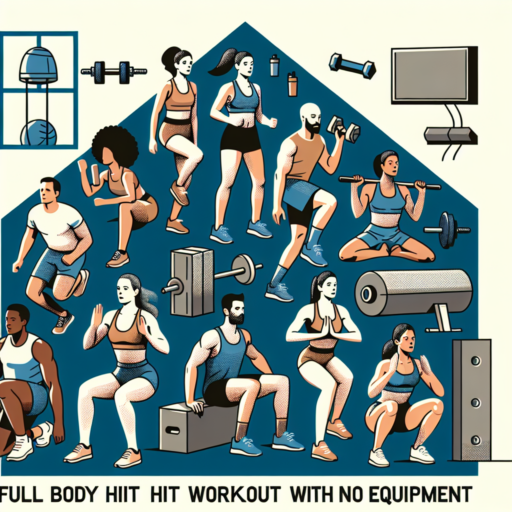What is Tabata and How Does it Work for Beginners?
Tabata is a high-intensity interval training (HIIT) workout, featuring exercises that last four minutes. It is named after Izumi Tabata, a Japanese scientist who discovered this method by comparing it to moderate intensity training. This form of workout is particularly appealing for beginners due to its simplicity and the minimal time requirement. You perform an exercise at full effort for 20 seconds, rest for 10 seconds, and repeat this cycle for four minutes or eight rounds.
For beginners, Tabata offers a flexible and efficient way to gain fitness. It starts with choosing exercises that you are comfortable with, such as jumping jacks, squats, or even brisk walking. The key is to perform your chosen exercise with maximum effort during the active phase. This intensity helps to spike your heart rate, leading to increased calorie burn and improved cardiovascular health.
Incorporating Tabata into your routine can seem daunting at first, but its structure is ideal for those new to exercise. To ensure consistency and safety, start with exercises that use your body weight and focus on form over speed. As you grow more accustomed to the intensity, you can add more challenging exercises or increase the number of cycles.
The Benefits of Tabata Training for Beginners
Tabata training, a form of high-intensity interval training (HIIT), is making waves in the fitness world, especially among beginners. The core appeal of Tabata lies in its efficiency and versatility. This method involves short bursts of intense exercise followed by a brief period of rest, making it an ideal regimen for those new to the fitness journey. In just a few minutes, Tabata can offer a comprehensive workout that boosts cardiovascular health, improves endurance, and aids in weight loss.
Enhances Cardiovascular Health
One of the paramount benefits of Tabata training for beginners is its ability to significantly improve cardiovascular health. By pushing the heart rate to its peak through quick, intense bursts of activity, practitioners can enjoy the benefits of an extended cardio session in just four minutes. This efficiency not only makes Tabata an accessible form of exercise but also encourages consistency and adherence to a fitness routine, which is crucial for heart health.
Boosts Endurance and Stamina
Despite the misconception that only prolonged activities can improve endurance, Tabata challenges and changes this narrative. The rapid succession of exertion and recovery phases in a Tabata workout enhances both aerobic and anaerobic capacity. Over time, this leads to significant improvements in overall stamina and endurance, empowering beginners to tackle more challenging workouts and daily activities with greater ease.
In summary, Tabata training offers a multitude of benefits that cater especially well to beginners. Its approach to exercise – emphasizing short, high-intensity workouts – not only makes it an efficient choice for those with busy schedules but also a powerful tool for improving one’s health and physical capabilities from the start of their fitness journey.
Starting Out: Essential Tips for Beginner Tabata Training
Embarking on Tabata training can be both exciting and intimidating for beginners. Originating in Japan, this high-intensity interval training (HIIT) approach guarantees efficient workouts in short periods. Before diving into the complex world of Tabata, it’s vital to arm yourself with some essential tips that will help you start on the right foot, ensuring your journey is not just effective but also safe.
Understand the Fundamentals of Tabata
First and foremost, understanding what Tabata entails is crucial. Tabata consists of 20 seconds of ultra-intense exercise followed by 10 seconds of rest. This cycle is typically repeated eight times for a total of four minutes of exercise. For beginners, it’s essential to start with exercises you’re comfortable with, to focus on maintaining form over speed or intensity. Beginner-friendly exercises like squats, push-ups, and lunges can be excellent to incorporate into your Tabata regimen.
Don’t Skip the Warm-Up
Given the intensity of Tabata workouts, warming up cannot be overstated. A comprehensive warm-up prepares your body for the upcoming exertion, significantly reducing the risk of injury. Spend at least five to ten minutes on light aerobic exercises such as jogging or jumping jacks followed by dynamic stretches. This preparation phase is crucial in enhancing your performance and ensuring your body is well-equipped to handle the high-intensity nature of Tabata training.
As a beginner, it’s imperative to listen to your body throughout your Tabata journey. Starting with two to three sessions a week can help your body adjust without overwhelming it. Remember, Tabata training is highly demanding, and adequate recovery is just as important as the workout itself. Embrace the process, and soon, you’ll find yourself mastering this efficient and effective training methodology.
5 Beginner-Friendly Tabata Workouts to Try Today
Embarking on a fitness journey can be daunting, especially with the vast array of workout regimens out there. However, Tabata workouts, known for their short bursts of intense exercise followed by brief rest periods, offer a perfect entry point. These 5 beginner-friendly Tabata workouts are tailored to help you dip your toes into the fitness world without feeling overwhelmed. Each routine is designed to fire up your metabolism, boost your endurance, and introduce you to the transformative world of high-intensity interval training (HIIT) in a manageable way.
Understanding the Fundamentals of Tabata
Before diving into the workouts, grasp the core principle of Tabata: 20 seconds of all-out effort, followed by 10 seconds of rest, repeated 8 times for a total of 4 minutes per exercise. This pattern is scientifically proven to improve aerobic and anaerobic capacity more effectively than traditional long-duration exercises. The key to a successful beginner-friendly Tabata workout lies in selecting movements that are simple yet effective, ensuring you maintain proper form while pushing your limits safely.
Tabata Workouts to Kickstart Your Fitness Journey
- Bodyweight Squats: They’re simple, require no equipment, and target major muscle groups – perfect for beginners.
- Push-Ups: Modify by dropping to your knees if needed, focusing on form to engage your chest, shoulders, and core.
- Jumping Jacks: A classic cardio move that boosts heart rate while improving coordination and stamina.
- Mountain Climbers: Great for building core strength and cardiovascular endurance, easily modifiable for any fitness level.
- Plank Holds: While not a traditional Tabata movement, incorporating plank holds can improve core stability and mental toughness.
Starting with these 5 beginner-friendly Tabata workouts will not only introduce you to a highly effective training method but also build a solid foundation of fitness that will benefit your health journey in the long run. Remember, the focus should be on performing each movement with precision, rather than on speed, to maximize results while minimizing the risk of injury.
No se han encontrado productos.
How to Structure Your First Tabata Workout as a Beginner
Embarking on your first Tabata workout can seem daunting. This high-intensity interval training (HIIT) method emphasizes short, powerful bursts of activity, followed by a brief rest period. As a beginner, it’s crucial to structure your workouts for success without overwhelming yourself. The following insights will guide you through four fundamental steps to get you started with Tabata.
Initiate with a Warm-Up
Starting with a warm-up is fundamental to prevent injuries and prepare your body for the intense activity ahead. A good five-minute routine of dynamic stretches and low-intensity cardiovascular exercises like jogging in place or jumping jacks will increase your heart rate and prepare your muscles for the workout.
Select Your Exercises Wisely
Tabata workouts are versatile, allowing you to incorporate a variety of exercises. As a beginner, focus on selecting exercises that target different muscle groups and do not require complex equipment or advanced skills. Consider simpler movements like squats, push-ups, and lunges. These exercises ensure you maintain form throughout the session, reducing the risk of injury while maximizing the workout’s effectiveness.
Understand the Timing
The core principle of Tabata is the pattern of 20 seconds of intense work followed by 10 seconds of rest. This cycle is traditionally repeated eight times for a total of four minutes. As you start, it’s essential to strictly adhere to this timing to get the full benefits of the Tabata method. Utilize a timer or a Tabata-specific app to keep track of your intervals accurately.
Beginner Tabata Mistakes to Avoid for Effective Results
Embarking on a Tabata training journey is an exhilarating way to enhance your fitness regime. However, as beginners, it’s easy to fall into certain pitfalls that can hinder the effectiveness of your workouts. Recognizing and avoiding these mistakes is crucial for achieving the optimal results that Tabata has to offer. By sidestepping these common errors, you set the stage for a more efficient, safe, and enjoyable fitness journey.
Misunderstanding the Intensity
One fundamental mistake many beginners make is not grasping the true intensity required during the 20 seconds of extreme effort in Tabata. Achieving the high-intensity level that Tabata demands means pushing your limits, but not beyond what your body can safely handle. Overestimating your capacity can lead to burnout or injury, while underestimating it can result in underwhelming results. Finding that sweet spot is essential for maximizing the benefits of your Tabata workouts.
Skipping the Warm-up and Cool-down
Another significant error is the oversight of proper warming up and cooling down. A comprehensive warm-up is vital to prepare your muscles and cardiovascular system for the high-intensity bursts, whereas a cool-down helps to gradually bring your heart rate back to its resting state, promoting recovery and reducing the risk of soreness. Beginners might overlook these crucial steps in their enthusiasm to dive into the workout, not realizing that these components are foundational for a safe and effective Tabata routine.
Understanding and rectifying these beginner Tabata mistakes is a step forward in refining your workout strategy. Paying attention to the intensity, along with incorporating proper warm-up and cool-down routines, will ensure that you reap the maximum benefits from your Tabata sessions. This approach not only improves your physical results but also safeguards your health, enabling a sustainable and fruitful fitness journey.
Tracking Progress: What Beginners Should Look for With Tabata
When embarking on a Tabata workout regime, tracking progress is crucial for beginners to both motivate themselves and ensure they are getting the most out of their efforts. Tabata, known for its high-intensity interval training (HIIT) structure, can significantly boost fitness levels, but understanding what progress markers to watch can be the difference between hitting a plateau and continually advancing.
Initially, beginners might notice an increase in endurance and strength. This is one of the first signs that the Tabata workouts are making an impact. Tracking how many rounds you can complete of a particular exercise within each Tabata sequence, or noting any increases in the weight you can manage, can be excellent indicators of your growing strength and endurance levels.
Another critical area to monitor is recovery time. Tabata’s intensity demands a lot from the body, and how quickly you recover between sessions can tell you a lot about your improving fitness. A reduction in recovery time often means your body is becoming more efficient at dealing with the high demands of Tabata exercises. Recording this can be as simple as noting how you feel days after a workout or how ready you feel for the next session.
Supplementing Your Tabata Training: Nutrition and Recovery Tips for Beginners
Embarking on a Tabata training journey can be incredibly rewarding, but to fully reap the benefits and ensure safety, it’s crucial to pay close attention to nutrition and recovery. Many beginners overlook these components, yet they are as important as the workout itself. Proper fueling and strategic recovery strategies can significantly enhance your performance and results.
Nutrition for Optimal Performance
When it comes to Tabata training, your body needs a precise blend of nutrients to perform at its peak and to repair itself afterward. A focus on a diet rich in lean proteins, complex carbohydrates, and healthy fats is essential. Before a workout, a meal that’s high in complex carbohydrates and protein can provide the energy needed to power through those intense intervals. Post-workout, incorporating protein can help in muscle recovery and growth, while carbohydrates can replenish energy stores.
Recovery to Maximize Gains
Proper recovery is just as crucial as the workout itself. Incorporating adequate rest, hydration, and active recovery techniques such as stretching or gentle yoga can aid in muscle repair and prepare your body for the next session. Understanding the significance of hydration cannot be overstressed; water supports every metabolic function and nutrient transfer in the body and significantly affects energy levels and overall performance.
Frequently Asked Questions About Beginner Tabata Training
When starting with Tabata training, newcomers often have a barrage of questions about this high-intensity interval training (HIIT) method. Recognized for its efficiency in improving cardiovascular health and aiding in fat loss, Tabata training is both admired and feared by beginners. Below, we address some of the most frequently asked questions to help demystify the basics of Tabata training for those new to the concept.
What Exactly is Tabata Training?
Tabata training is a form of high-intensity interval training that involves 20 seconds of ultra-intense exercise followed by 10 seconds of rest, repeated for 4 minutes (or 8 cycles). Originally developed by Japanese scientist Dr. Izumi Tabata, this method has gained considerable popularity for its ability to deliver significant aerobic and anaerobic benefits in a condensed timeframe.
How Often Should Beginners Practice Tabata Workouts?
For beginners, the key to success with Tabata training lies in moderation and gradual progression. Starting with two to three times a week is advisable, allowing ample recovery time between sessions. As your stamina and strength improve, you may increase the frequency of your workouts. It’s important to listen to your body and ensure you’re giving it the necessary time to recuperate and adapt to this rigorous training regimen.
Incorporating Tabata workouts into your fitness routine can be a game-changer, particularly for those pressed for time but aiming for maximal health benefits. Remember, consistency and proper technique are paramount. For beginners eager to dive into Tabata training, starting with a clear understanding and realistic expectations will pave the way for a rewarding journey towards improved fitness and well-being.




